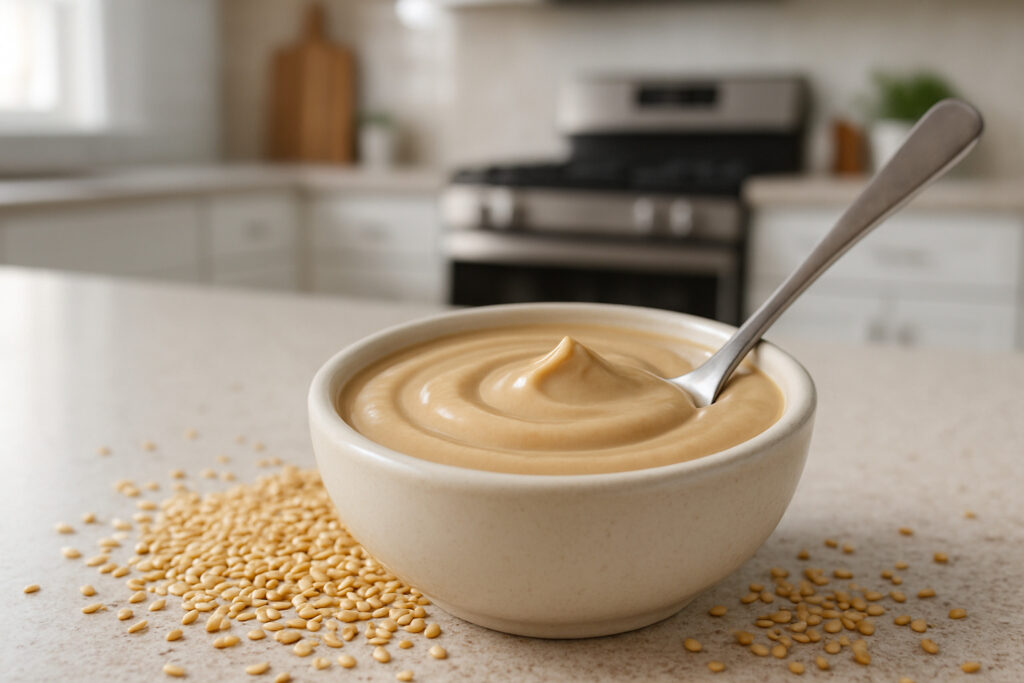Why Tahini Is Taking Over Kitchen Pantries Worldwide
What is tahini? It’s a creamy paste made from ground sesame seeds that’s become a must-have ingredient for food lovers everywhere. This Middle Eastern staple transforms humble sesame seeds into a rich, nutty condiment that works in both sweet and savory dishes.
Quick Answer:
- What it is: Ground sesame seed paste
- Origin: Middle Eastern and Mediterranean cuisines
- Taste: Nutty, earthy, slightly bitter
- Texture: Smooth and creamy (like natural peanut butter)
- Diet-friendly: Vegan, gluten-free, dairy-free
- Main uses: Hummus, sauces, baking, dressings
If you’ve ever made hummus, you know that tahini is a key ingredient. But this versatile paste does so much more than create the perfect dip. From drizzling over roasted vegetables to mixing into chocolate chip cookies, tahini brings a unique depth of flavor that’s hard to replicate.
Made from just sesame seeds (and sometimes a touch of oil), it packs serious nutritional punch with healthy fats, protein, and minerals like copper and selenium. For food travelers seeking authentic flavors, tahini opens doors to traditional Middle Eastern cooking while fitting perfectly into modern dietary needs.
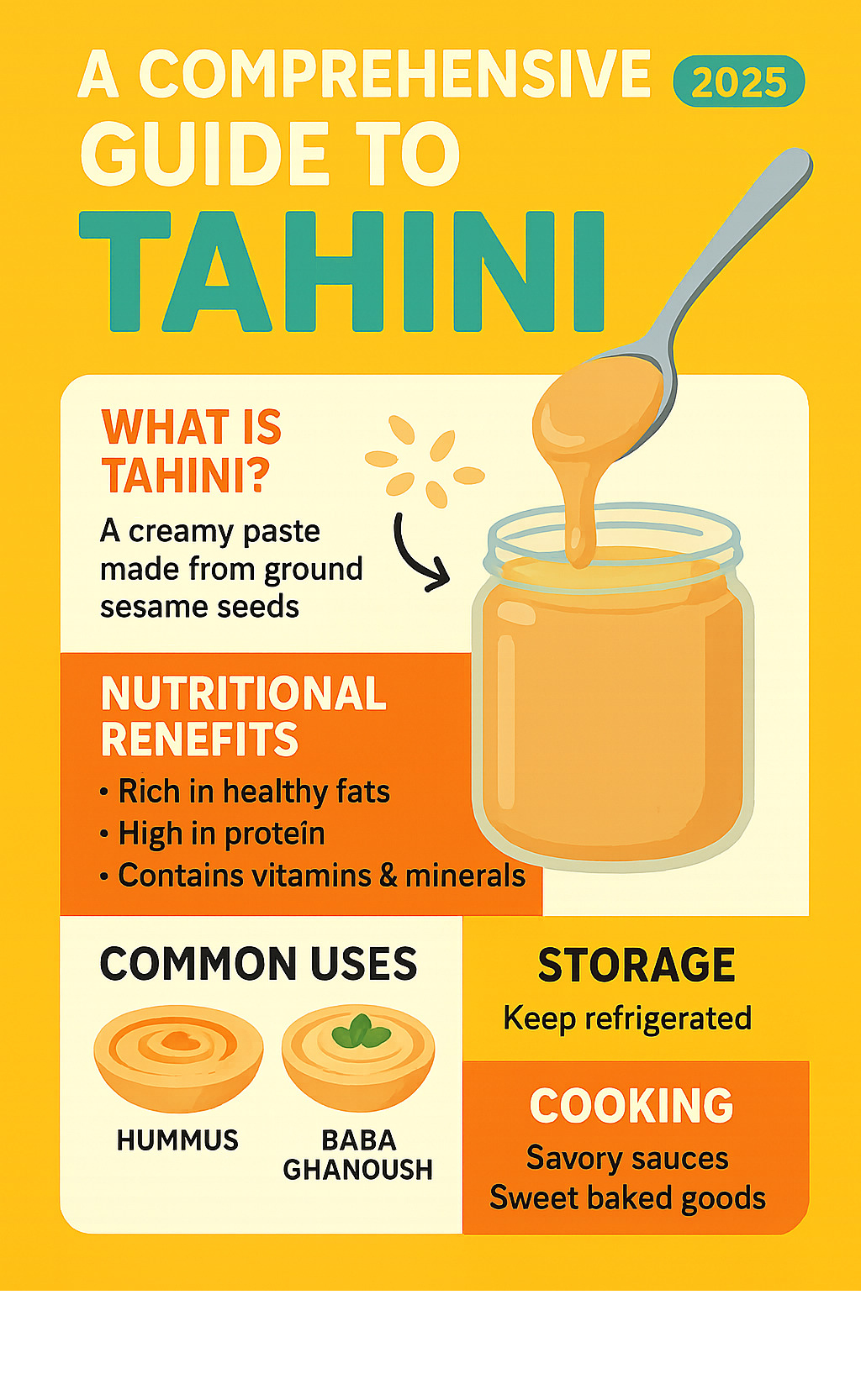
Must-know what is tahini terms:
What Is Tahini? Origins, Definition & Taste
Picture ancient Mesopotamian cooks grinding sesame seeds over 4,000 years ago, creating what would become one of the world’s most beloved condiments. What is tahini if not a testament to human ingenuity? These early food innovators found that grinding humble sesame seeds released magical oils that transformed into a creamy, luxurious paste.
The word “tahini” comes from the Arabic root ṭ-ḥ-n, which simply means “to grind.” It’s a perfect name for this ancient process that turns tiny seeds into culinary gold. The scientific research on sesame’s health merits shows why our ancestors were onto something special.
What is tahini in its purest form? It’s finely ground sesame seeds – usually hulled and toasted – that release their natural oils during grinding. This creates a thick, creamy paste with a distinctive nutty flavor that’s both earthy and rich. Think of it as the sophisticated cousin of peanut butter, with more complexity and depth.
Good tahini should taste rich and nutty, similar to roasted sesame oil but in paste form. You’ll notice mildly savory notes with pleasant earthy undertones. The texture should be smooth and creamy, never chalky or dry.
The Meaning Behind “what is tahini” in Different Cultures
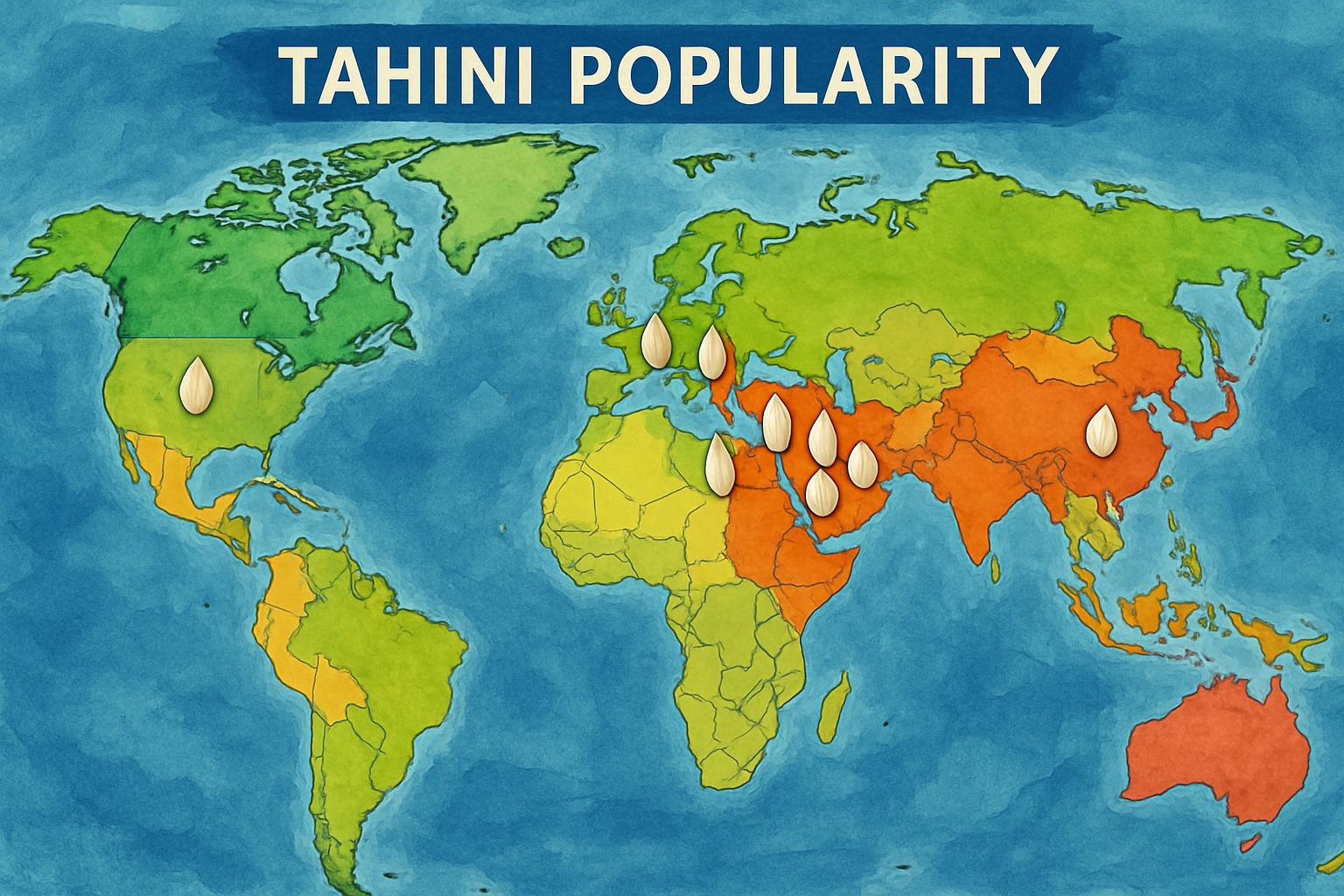
Travel the world and you’ll find that what is tahini means something slightly different everywhere you go. Each culture has adopted this sesame seed paste and made it their own.
In Arabic-speaking regions, they call it “tahina” and consider it essential for authentic hummus and baba ghanoush. Greek cuisine features “tachini,” often mixed with honey as a traditional sweet treat. Chinese sesame paste takes a different approach, with longer-toasted seeds creating a deeper, more robust flavor essential in dan dan noodles.
Turkish tahin frequently gets paired with pekmez (grape molasses) for a traditional breakfast spread, while Armenian and Georgian cuisines showcase tahini’s versatility in both sweet confections and savory sauces.
Quick Answer: what is tahini in One Sentence
What is tahini? It’s a creamy, nutrient-dense seed butter made from ground sesame seeds that’s naturally vegan and gluten-free, serving as a pantry essential for both traditional Middle Eastern dishes and modern fusion cooking.
How Tahini Is Made: From Sesame Seed to Silky Paste
Making what is tahini becomes clearer when you understand the journey from tiny sesame seeds to that luxuriously smooth paste we love. The process might seem simple, but each step dramatically affects the final flavor and texture.
The journey begins with a crucial decision: hulled versus unhulled seeds. Hulled seeds have their outer shells removed, creating that silky, mild tahini you’ll find in most Middle Eastern restaurants. Unhulled seeds keep their shells, resulting in a more nutritious but slightly grittier paste.
Next comes the roasting choice that defines your tahini’s personality. Raw tahini uses unroasted seeds for a lighter, more neutral taste. Roasted tahini develops those deep, nutty notes that make your kitchen smell incredible.
Traditional tahini makers follow a time-honored process. They start by soaking the sesame seeds in water, then crushing and using salt water flotation to separate good kernels from bran pieces. The toasting stage requires real skill – kernels get heated just until aromatic, usually 3 to 5 minutes. Finally, the grinding process transforms those toasted seeds into creamy paste as they release their natural oils.
| Hulled Tahini | Unhulled Tahini |
|---|---|
| Smooth, creamy texture | Slightly gritty feel |
| Mild, nutty flavor | More intense, sometimes bitter |
| Light beige color | Darker brown appearance |
| Perfect for everyday cooking | Higher in fiber and minerals |
| Great for beginners | Best for bold, complex flavors |
Commercial Production vs Homemade Method
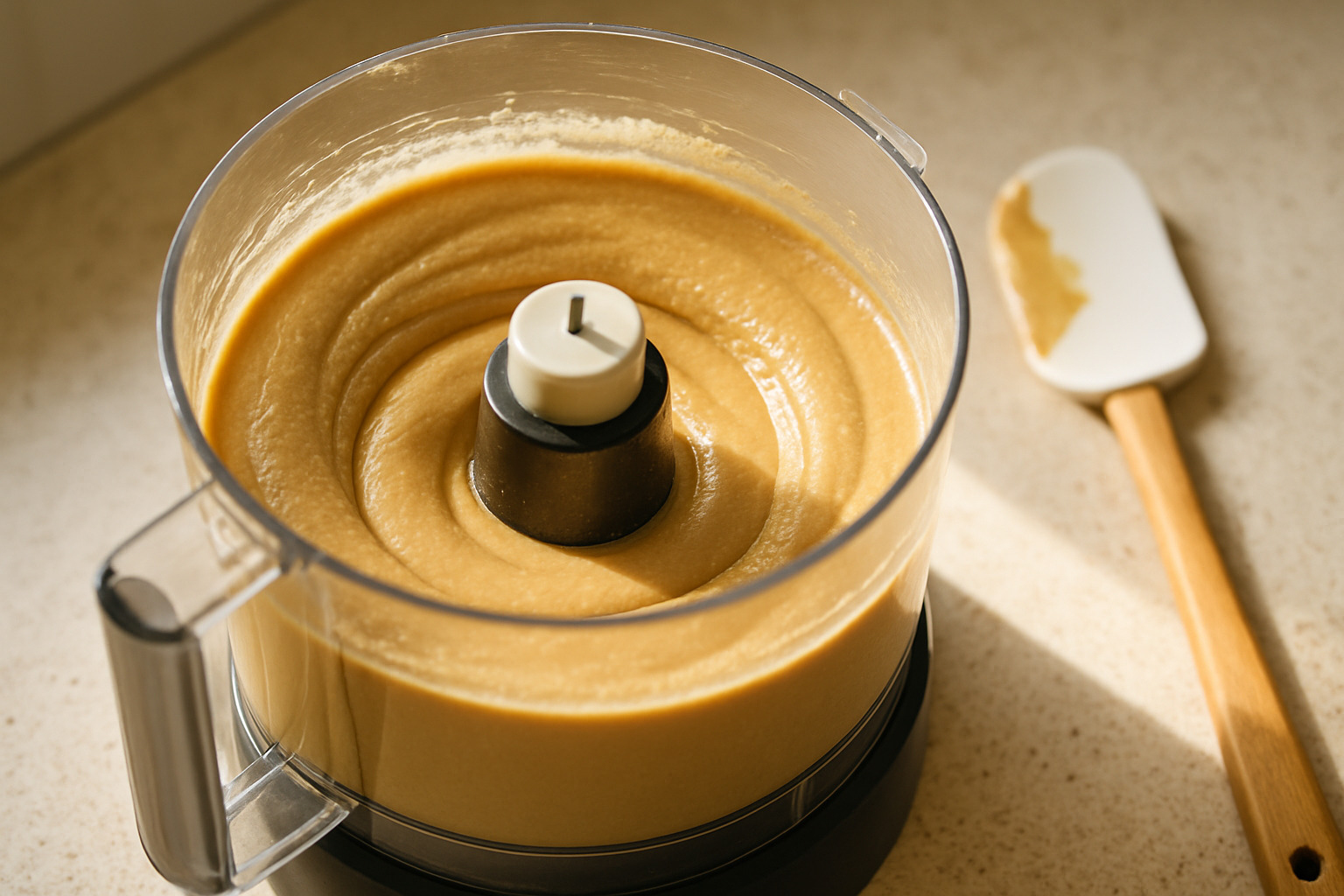
Commercial tahini production uses specialized stone grinders that create incredibly fine textures – much smoother than most home cooks can achieve. They process massive batches with precise temperature control during grinding.
Making tahini at home offers absolute freshness and complete control over flavor. You’ll need a high-powered food processor, a dry skillet for toasting, and patience.
Start with 2 cups of hulled sesame seeds in a dry skillet over medium-low heat. Toast for 3 to 5 minutes, stirring constantly until they smell nutty. Let them cool completely – hot seeds create paste that’s too thick.
Process the cooled seeds until they look like wet sand (about 2 minutes). With the processor running, slowly drizzle in 3 to 4 tablespoons of neutral oil. Keep processing for 3 to 4 minutes until smooth and pourable.
Troubleshooting Common Issues

Oil separation is completely normal and indicates quality tahini without chemical emulsifiers. Simply stir vigorously before use.
Bitterness problems usually indicate old tahini or improperly processed seeds. Check expiration dates and ensure you’re using hulled seeds when making homemade versions.
Texture troubles: If too thick, add neutral oil one teaspoon at a time. Grainy texture means your food processor needs more time or a small amount of oil to help grinding.
Storage makes a big difference – homemade versions stay fresh about a month refrigerated, while quality store-bought tahini lasts up to 6 months in the fridge after opening.
Nutritional Benefits & Dietary Questions
When you’re wondering what is tahini from a health perspective, you’ll find it’s a genuine nutritional powerhouse. Just one tablespoon delivers about 89 calories with 3 grams of complete plant-based protein and 8 grams of healthy fats that are primarily monounsaturated.
What really sets tahini apart is its mineral density. A single tablespoon provides 27% of your daily copper needs and 9% of your selenium, plus meaningful amounts of phosphorus, zinc, and iron. The secret weapon is sesamol – a unique antioxidant compound exclusive to sesame seeds.
Scientific research on sesame’s health merits continues to reveal promising findings about this ancient ingredient.
Is Tahini Healthy? Evidence-Based Benefits
Research on tahini’s health benefits is encouraging. A 2014 study found that people who ate about 40 grams of sesame seeds daily saw significant improvements in cholesterol levels within two months.
Heart health gets a boost from tahini’s monounsaturated fats, which work similarly to olive oil to support healthy cholesterol levels. Recent 2021 research showed regular sesame consumption can reduce chronic inflammation by lowering key inflammatory markers.
For bone support, tahini provides plant-based calcium along with phosphorus and magnesium. Important note: Sesame allergies can be severe, so anyone with sesame sensitivity should avoid tahini completely.
Special Diet Compatibility
Vegan cooking benefits enormously from tahini’s creamy richness, creating luxurious dairy-free sauces and adding protein to plant-based meals. Gluten-free diets can safely include pure tahini, as sesame seeds naturally contain no gluten.
Keto dieters love tahini because it fits perfectly into low-carb eating plans with only 3 grams of carbs per tablespoon. For those with tree nut allergies, tahini can serve as an excellent alternative to almond or peanut butter, provided you’re not sensitive to sesame seeds.
For more insights on making thoughtful food choices, check out our guide on Sustainable Food Choices.
Cooking with Tahini: Savory & Sweet Inspiration

Once you understand what is tahini, you’ll find it’s like having a secret weapon in your kitchen. This creamy sesame paste works magic in both sweet and savory dishes, adding rich nuttiness that transforms ordinary recipes.
The beauty of cooking with tahini lies in its incredible versatility. In savory dishes, it creates silky smooth sauces without dairy, while in sweet treats, it adds moisture and complexity. Think of tahini as the sophisticated cousin of peanut butter.
Pro tip: Start with small amounts when cooking with tahini. Its rich flavor can easily take over a dish, so add gradually and taste as you go.
Classic Savory Recipes Featuring Tahini
Perfect hummus starts with the right tahini-to-chickpea ratio. For one can of chickpeas, use about 1/4 cup of tahini, and add ice water gradually while blending for restaurant-quality smoothness.
Tahini sauce might be the most useful condiment you’ll ever make. Whisk together half a cup of tahini with fresh lemon juice, minced garlic, and water until it reaches heavy cream consistency. This golden sauce transforms grilled vegetables, roasted chicken, or simple pasta.
For salad dressings, mix three tablespoons of tahini with olive oil, lemon juice, Dijon mustard, and honey. Thin with water until it drizzles perfectly. Roasted vegetables become restaurant-worthy when finished with tahini thinned with lemon juice and honey.
For authentic techniques, explore our guide to Middle Eastern Food.
Unexpected Sweet Treats with Tahini
Tahini chocolate chip cookies will change how you think about baking. Replace half the butter in your favorite recipe with tahini for incredibly moist, chewy cookies with sophisticated nutty undertones.
Banana bread gets a grown-up makeover with a quarter cup of tahini added to the batter. Energy balls made with tahini, dates, vanilla, and chopped pistachios taste like homemade halva. Tahini brownies create beautiful marbled patterns when swirled into batter before baking.
For more Middle Eastern dessert inspiration, check out our article on Turkish Delight.
Smart Substitutions & Alternatives
Sunflower seed butter comes closest to tahini’s neutral flavor and smooth texture. Almond butter works but adds sweetness, while cashew butter creates even creamier texture though milder flavor.
Going the other direction, tahini makes excellent substitutions too. Try using tahini instead of peanut butter in satay sauces for more sophisticated flavor, or replace almond butter with tahini in energy balls when you want less sweetness.
Buying, Storing & Selecting the Best Tahini

Walking down the condiment aisle, you’ll find tahini options ranging from budget-friendly to artisanal varieties. Knowing what is tahini quality looks like saves both money and disappointment.
Quality tahini should have a light beige to golden color – avoid anything gray or unnaturally dark. When you open the jar, you should smell rich, toasted sesame notes. The texture should be smooth and creamy, flowing like thick honey when stirred.
Don’t worry about oil on top – that’s normal and indicates natural tahini without chemical emulsifiers. Reading labels should reveal refreshingly short ingredient lists: sesame seeds, maybe oil, occasionally salt. Look for terms like “stone ground” or “small batch.”
How to Choose a Jar You’ll Love
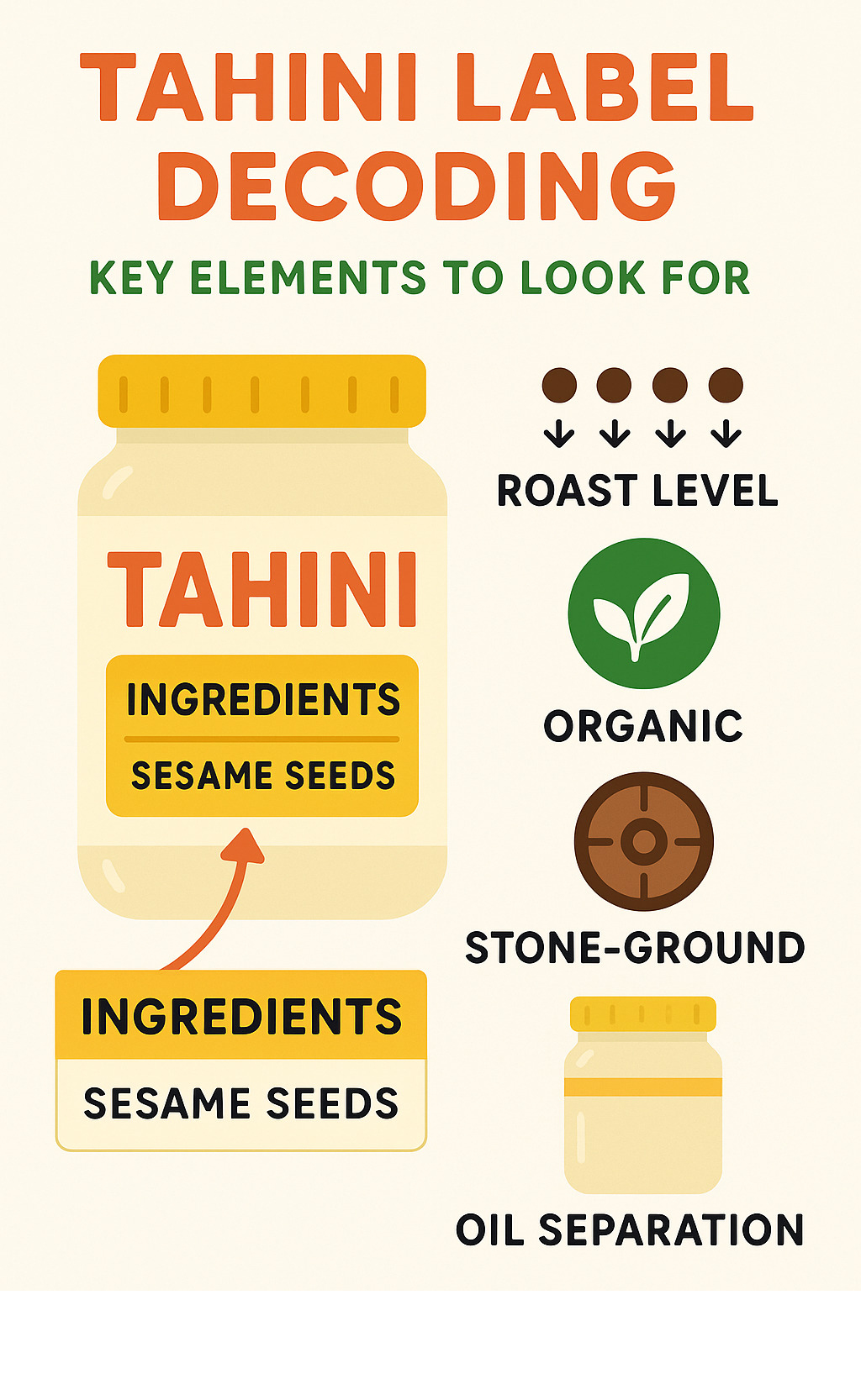
Roast level makes a huge difference. Light roast tahini offers mild, versatile flavor perfect for both sweet and savory applications. Medium roast provides classic nutty sesame flavor, while dark roast delivers intense depth that shines in bold Middle Eastern recipes.
Smooth tahini from hulled seeds creates the creamiest sauces, while rustic varieties add interesting texture. Glass jars preserve flavor better than plastic and let you see what you’re buying. Quality tahini costs more – expect $8-15 for a good 10-ounce jar – but the difference in taste makes it worthwhile.
Proper Storage & Shelf-Life Extension
Unopened tahini lives happily in your pantry for 2-3 years in a cool, dry place. Once opened, room temperature keeps it fresh about a month, while refrigerated tahini maintains quality for up to 6 months.
Pro tip: Store your jar upside down occasionally to minimize oil separation. Always use clean utensils and stir before each use.
Signs tahini has gone bad include rancid or sour smell, mold growth, extremely bitter taste, or unusual color changes. Trust your nose – fresh tahini smells wonderfully nutty.
Minimize air exposure by transferring remaining tahini to smaller containers as you use it up. This simple step significantly extends freshness.
Frequently Asked Questions about Tahini
As what is tahini becomes more common among home cooks exploring this versatile ingredient, we’ve noticed the same questions appearing repeatedly. Let’s address the most pressing concerns about this sesame seed paste.
Can I eat tahini if I’m allergic to nuts?
Tahini is made from sesame seeds, not tree nuts, so it’s technically safe for people with tree nut allergies like almonds or walnuts. However, sesame itself is a major allergen that can trigger severe reactions. The FDA now requires sesame to be labeled as a major allergen.
Many facilities processing tahini also handle tree nuts, so check labels for cross-contamination warnings. When in doubt, consult your allergist before trying tahini. For those who can’t enjoy tahini due to allergies, sunflower seed butter makes an excellent substitute.
Why does my tahini taste bitter?
Bitterness in tahini usually signals quality or storage issues. Age is the most common culprit – tahini develops increasingly bitter flavors as it ages, especially once opened. Natural oils can turn rancid when exposed to air, light, or heat.
Poor quality processing also creates bitterness. Some manufacturers use unhulled sesame seeds, which naturally taste more bitter. Over-roasted seeds produce burnt, acrid bitterness that no mixing can fix. Storage problems in warm conditions accelerate bitterness.
Quality what is tahini should taste rich and earthy with only subtle bitter notes that balance the overall flavor.
How long does homemade tahini last in the fridge?
Homemade tahini typically stays fresh for about one month refrigerated when stored properly in airtight containers. This shorter shelf life compared to commercial versions makes sense – home food processors can’t achieve the same refinement as industrial stone grinders.
Storage technique matters tremendously. Use glass containers with tight-fitting lids and clean utensils to prevent bacteria. Watch for spoilage signs: rancid smell, mold growth, extremely bitter taste, or unusual color changes.
Make smaller batches more frequently rather than large quantities that sit too long. Consider freezing portions in ice cube trays, then transferring to freezer bags for up to six months.
Conclusion
What is tahini? It’s your passport to a world of flavor spanning continents and centuries. This humble sesame seed paste has traveled from ancient Mesopotamian temples to modern New York City kitchens, proving some ingredients are truly timeless.
With just one jar of tahini in your pantry, you can whip up authentic Middle Eastern hummus, drizzle creamy tahini sauce over roasted vegetables, and surprise your family with tahini chocolate chip cookies. That’s the magic of this versatile ingredient.
What makes tahini special isn’t just its rich, nutty flavor or impressive nutritional profile. It’s how this single ingredient connects us to global food traditions while fitting perfectly into modern dietary needs. Whether you’re vegan, gluten-free, or seeking healthier alternatives, tahini delivers without compromise.
Understanding what is tahini gives you confidence to experiment. You’ll find yourself reaching for that jar more often, finding new ways to add depth and richness to both familiar and adventurous dishes.
Your tahini success checklist: Choose quality products with minimal ingredients, store opened jars refrigerated, remember a little goes a long way, don’t worry about oil separation, and start simple while letting your taste buds guide your culinary journey.
Tahini bridges the gap between authentic tradition and modern innovation, offering a delicious way to honor ancient culinary wisdom while creating new memories in our own kitchens.
Ready to explore more incredible ingredients? Find fascinating flavors and culinary traditions in our comprehensive World Cuisine Exploration guide. Your next favorite ingredient is waiting to be finded.

